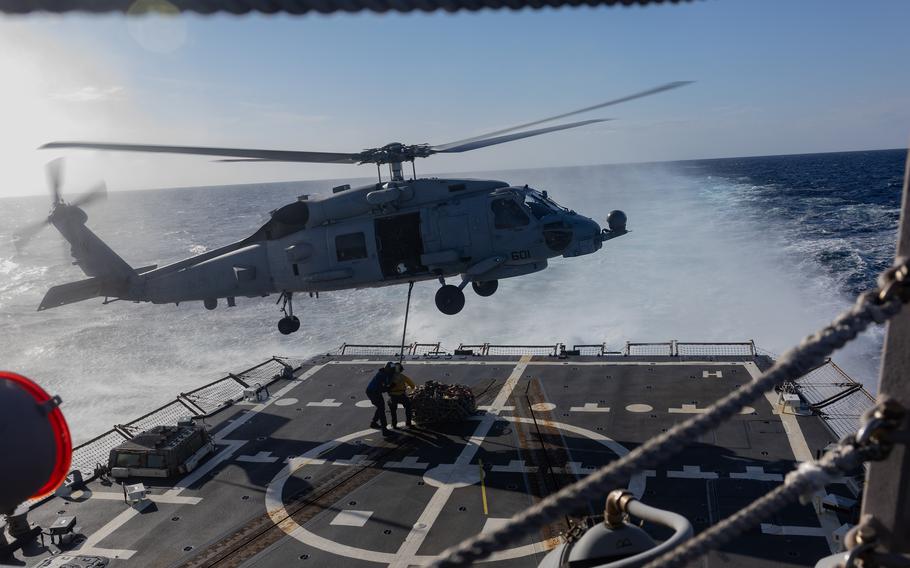
Sailors aboard the destroyer USS Oscar Austin attach a cargo hook to an MH-60R Sea Hawk helicopter during a replenishment drill on Dec. 16, 2024, in the Mediterranean Sea. (Jasmin L. Aquino/U.S. Navy)
NAPLES, Italy — U.S. Navy presence in the Mediterranean Sea is at its lowest in years, an indication the service is feeling the pinch of sustaining the fleet following long overseas deployments, analysts say.
There isn’t a carrier strike group or amphibious ready group in the region, a notable change since the near-constant presence of at least one of those groups in the Mediterranean since December 2022. The Navy hasn’t said if it plans to send more ships to Europe anytime soon.
Last week, a single destroyer, USS Oscar Austin, was on patrol in the eastern Mediterranean, USNI News reported on Dec. 30.
The only other Navy ships in the area on Friday appeared to be the fast-attack submarine USS Indiana, the oiler USS Laramie and the expeditionary sea base USS Woody Williams.
In 2022, naval presence in the Mediterranean and Black seas reached highs not seen since the Cold War as Russia prepared to invade Ukraine and the service surged forces to the region.
While some of those ships subsequently returned stateside, the Navy’s force in the region largely remained constant, increasing in the aftermath of Hamas’ attack on Israel in October 2023 amid concerns of a wider conflict.
The reasons behind the Navy’s current ship allocation in the Mediterranean are varied and complex, analysts said.
For example, it’s common for many ships to return to port during the holidays. And with a cease-fire agreement between Israel and Hezbollah in Lebanon, there’s less likelihood of a sudden crisis.
Meanwhile, the service is fighting Iranian-backed Houthi militants threatening ships in the Red Sea, among other competing priorities that are drawing resources.
But ultimately, the reduction in forces on patrol in the eastern Mediterranean boils down to having a fleet that is inadequately sized to meet demand, analysts said.
Presence in the Mediterranean is “partly threat-driven and situation-driven, and it’s all conditioned by (the fact that) there aren’t enough ships in the Navy,” said Bradley Martin, a retired Navy surface warfare officer and director of the Rand Corp. National Security Supply Chain Institute.
With limited U.S. ashore bases in the region, the presence of a carrier in the eastern Mediterranean offers more flexibility. It also signals to Russia and other competitors that the U.S. is militarily committed to the region, naval experts said.
“The European theater and the mischief and war-making at work in that theater demands a strong U.S. response in concert with (allies),” said Bryan McGrath, managing director of the Maryland-based national security and defense consulting firm the Ferry Bridge Group.
“One of the ways you deter another power is to show that other power that you are willing to risk things that are important to you,” McGrath added. “That is the essence of deterrence, and we don’t routinely do that.”
That doesn’t mean the U.S. lacks the resources to respond to a crisis in the region, Martin and other analysts pointed out.
In addition to Oscar Austin, four other destroyers are based at Rota, Spain, and could be in the area within days. Air Force planes from Aviano Air Base in northern Italy and other locations in Europe and the Middle East could be used if needed.
And navies from NATO countries, such as Italy, France, Greece and Spain, regularly patrol the Mediterranean.
“It’s a little awkward that we don’t have something in the eastern Med for anyone that likes having the reassurance of a surface ship,” said Michael Bohnert, a Rand Corp. analyst. “But from a military and a practical perspective, it’s perfectly fine.”
Still, multiple extended deployments have taken a toll on Navy ships and played havoc with maintenance and repair schedules, said Bryan Clark, director of the Hudson Institute’s Center for Defense Concepts and Technology.
For example, the aircraft carrier USS Dwight D. Eisenhower spent roughly nine months deployed, fending off Houthi attacks at a combat tempo unseen in decades.
The Navy also extended the deployments of the aircraft carrier USS Gerald R. Ford and the Bataan Amphibious Ready Group, among other ships and groups.
Those extended deployments hurt an already tight maintenance and repair schedule, creating a domino effect of delays exacerbated by the need for additional work from the wear and tear of having a ship at sea for a longer period, Clark said.
“The Navy worked a lot of ships hard over the last year-and-a-half with what’s going on in Israel and the Middle East,” Clark said. “Those operations put a huge stress on the force.”
In 2024, the service’s deployable battle force was estimated to be 293, down three from the year before, Stars and Stripes reported in March 2023. That number includes 11 aircraft carriers in various cycles of operation, deployment and maintenance.
Three carriers — USS George Washington, USS Carl Vinson and USS Harry S. Truman — are now deployed.
In the final analysis, shortage of ships and manpower explains why the service has fewer ships in the Mediterranean, said McGrath, who served 21 years in the Navy, including as commander of the destroyer USS Bulkeley.
He advocates for a constant carrier and amphibious presence in Europe, the Middle East and the Indo-Pacific. Those three major areas of the world are where the U.S. has enduring interests.
Yet “we have a Navy barely sized to accomplish our desires in two regions,” he said.
“If we were to be, in any one of those three areas or some combination thereof, actually at war, we are in desperate trouble,” McGrath added.